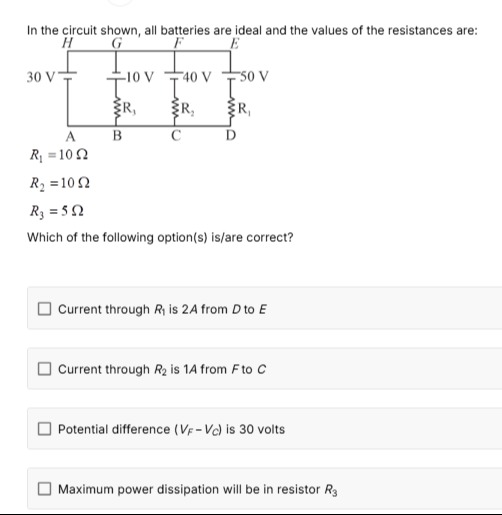Question
Question: In the circuit shown, all batteries are ideal and the values of the resistances are: $R_1 = 10 \O...
In the circuit shown, all batteries are ideal and the values of the resistances are:
R1=10Ω
R2=10Ω
R3=5Ω
Which of the following option(s) is/are correct?

A
Current through R1 is 2A from D to E
B
Current through R2 is 1A from F to C
C
Potential difference (VF−VC) is 30 volts
D
Maximum power dissipation will be in resistor R3
Answer
None of the options are correct. The correct values are:
- Current through R1 is 5A from E to D.
- Current through R2 is 4A from F to C.
- Potential difference (VF−VC) is 40 volts.
- Maximum power dissipation will be in resistor R1.
Explanation
Solution
Here's how to analyze the circuit and determine the correct answers:
-
Node Potentials:
- Assume the potential at node A is VA=0V (ground).
- Since the 30V battery is connected between H and A, with H being the positive terminal, VH=30V.
- The points H, G, F, and E are connected by a wire, so they are at the same potential: VG=VF=VE=30V.
- The 10V battery is connected between G and B, with G being the positive terminal, so VB=VG−10V=30V−10V=20V.
- The 40V battery is connected between F and C, with F being the positive terminal, so VC=VF−40V=30V−40V=−10V.
- The 50V battery is connected between E and D, with E being the positive terminal, so VD=VE−50V=30V−50V=−20V.
-
Currents through Resistors:
- R1: IR1=(VE−VD)/R1=(30V−(−20V))/10Ω=5A (from E to D).
- R2: IR2=(VF−VC)/R2=(30V−(−10V))/10Ω=4A (from F to C).
- R3: IR3=(VG−VB)/R3=(30V−20V)/5Ω=2A.
-
Power Dissipation:
- PR1=IR12∗R1=(5A)2∗10Ω=250W.
- PR2=IR22∗R2=(4A)2∗10Ω=160W.
- PR3=IR32∗R3=(2A)2∗5Ω=20W.
Therefore, R1 dissipates the maximum power.
